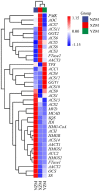Transcriptome Analysis of Antrodia cinnamomea Mycelia from Different Wood Substrates
- PMID: 36846623
- PMCID: PMC9946338
- DOI: 10.1080/12298093.2023.2175434
Transcriptome Analysis of Antrodia cinnamomea Mycelia from Different Wood Substrates
Abstract
Antrodia cinnamomea, an edible and medicinal fungus with significant economic value and application prospects, is rich in terpenoids, benzenoids, lignans, polysaccharides, and benzoquinone, succinic and maleic derivatives. In this study, the transcriptome of A. cinnamomea cultured on the wood substrates of Cinnamomum glanduliferum (YZM), C. camphora (XZM), and C. kanehirae (NZM) was sequenced using the high-throughput sequencing technology Illumina HiSeq 2000, and the data were assembled by de novo strategy to obtain 78,729 Unigenes with an N50 of 4,463 bp. Compared with public databases, about 11,435, 6,947, and 5,994 Unigenes were annotated to the Non-Redundant (NR), Gene Ontology (GO), and Kyoto Encyclopedia of Genes and Genome (KEGG), respectively. The comprehensive analysis of the mycelium terpene biosynthesis-related genes in A. cinnamomea revealed that the expression of acetyl-CoA acetyltransferase (AACT), acyl-CoA dehydrogenase (MCAD), 3-hydroxy-3-methylglutaryl-coenzyme A (HMG-CoA), mevalonate pyrophosphate decarboxylase (MVD), and isopentenyl diphosphate isomerase (IDI) was significantly higher on NZM compared to the other two wood substrates. Similarly, the expression of geranylgeranyltransferase (GGT) was significantly higher on YZM compared to NZM and XZM, and the expression of farnesyl transferase (FTase) was significantly higher on XZM. Furthermore, the expressions of 2,3-oxidized squalene cyclase (OCS), squalene synthase (SQS), and squalene epoxidase (SE) were significantly higher on NZM. Overall, this study provides a potential approach to explore the molecular regulation mechanism of terpenoid biosynthesis in A. cinnamomea.
Keywords: Antrodia cinnamomea; biosynthesis; de novo transcriptome; qRT-PCR; terpenoid.
© 2023 The Author(s). Published by Informa UK Limited, trading as Taylor & Francis Group on behalf of the Korean Society of Mycology.
Conflict of interest statement
No potential conflict of interest was reported by the author(s).
Figures






References
-
- Zhang BB, Guan YY, Hu PF, et al. . Production of bioactive metabolites by submerged fermentation of the medicinal mushroom Antrodia cinnamomea: recent advances and future development. Crit Rev Biotechnol. 2019;39(4):541–554. - PubMed
-
- Chen CY, Chien SC, Tsao NW, et al. . Metabolite Profiling and comparison of bioactivity in Antrodia cinnamomea and Antrodia salmonea fruiting bodies. Planta Med. 2016;82(3):244–249. - PubMed
-
- Cha WS, Ding JL, Choi DB.. Comparative evaluation of antioxidant, nitrite scavenging, and antitumor effects of Antrodia camphorata extract. Biotechnol Bioproc E. 2009;14(2):232–237.
-
- Mau JL, Huang PN, Huang SJ, et al. . Antioxidant properties of methanolic extracts from two kinds of Antrodia camphorata mycelia. Food Chem. 2004;86(1):25–31.
LinkOut - more resources
Full Text Sources
Other Literature Sources
Miscellaneous
